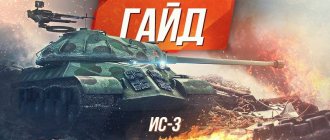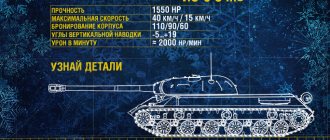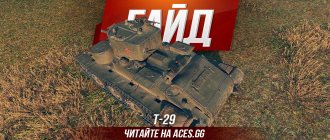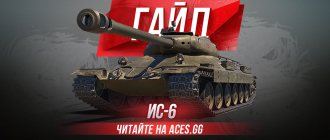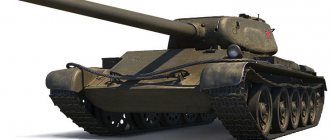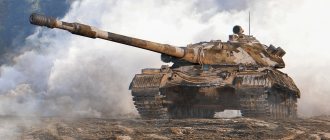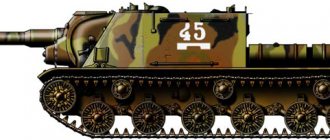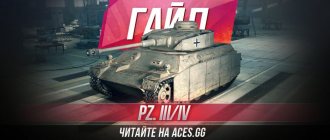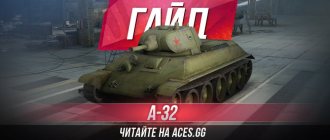Hello everyone and welcome to aces.gg!
Today we will talk about a very interesting tank that recently appeared in our game and became the main reward for the so-called LBZ 2.0, 3 “Second Front” campaign. Here is a detailed guide to TT level 10 USSR Object 279 early. This tank previously, when it first entered the super test, had a different name - Object 726. For the release, the developers renamed the vehicle. By the way, the original Object 279 is also present in the game client, but when and how we will be able to get it is still unknown.
You can get acquainted with LBZ 2.0 in detail here.
Detailed performance characteristics of Object 279 (r)
So, the main reward for completing LBZ 2.0 or 3 of the campaign, which is called “Second Front,” will be Object 279 (p) in World of Tanks. On the one hand, this is an ordinary Soviet level 10 TT with a weapon familiar to us all, which is installed on the IS-4 and T-10. On the other hand, the tank has quite interesting performance characteristics: hull shape, four-track suspension. Let's look at everything in order.
You should immediately pay attention to the safety margin - 2400 units is a good indicator. The maximum speed of 40 km/h is also a good indicator for a heavy tank. The specific power of 14.17 hp/t is a good indicator, but the tank will still not have ultra-high dynamics. What is puzzling is the resistance to different soils. The tank will drive very poorly on soft soils, which is not clear, because it has 4 tracks and the IRL Object 279 (r) was precisely designed for good maneuverability in bad terrain.
As mentioned above, the gun on this tank is quite familiar to all fans of the Soviet school of tank building, because it is found on many Soviet tanks in the game. Good armor penetration for both BB and KS, good one-time damage, good accuracy and aiming speed, good DPM. The only disappointment is UVN -5 - extremely little considering how tall the Object 279 (r) tank is.
Now we come to the most interesting part - booking. The Object 279 (r) is quite well armored, a curved VLD similar to the Object 907 with good armor ratings (170 mm) and ghosts can be pulled out at different angles quite well. The sides have 130 mm and are also located at an angle, which is very helpful when tanking with the side. The tower is also quite well armored, the weak points, as usual, are the roof and turrets. But the tank itself is tall, so targeting these areas will not be the easiest task.
Equipment for Object 279 (r)
There is no point in taking a lax approach to the selection and installation of additional modules; this aspect should take into account the strengths and weaknesses of the tank, optimally complementing its original characteristics. True, in our case this aspect will be quite standard, that is, the equipment for the Object 279 (r) tank
It’s better to put the following: 1. – will make our already good damage per minute even more noticeable, due to which the firepower will increase significantly. 2. – if there are obvious problems with accuracy, this module will not only allow you to shoot more confidently while moving, but also reduce your shooting speed after stopping. 3. – with this module you can achieve maximum viewing range with minimal effort.
However, there is a very worthy replacement for the third point, which in some ways will look even more in demand - this. Of course, we sacrifice review, but in return we get an increase in several important parameters at once, and in the case of pumped-up skills for review, all the disadvantages of such a choice are eliminated.
Penetration zones Object 279 Early
Let's start with the fact that it is better for inexperienced tankers to avoid this heavy force, choosing a lighter enemy. And it’s not just a matter of really fierce booking in any projection. It’s just that getting this tank directly depends on the player’s skill.
Believe me, if a tanker has fulfilled the conditions for receiving this equipment, then he knows how to handle it. This means that such a player is unlikely to expose vulnerable areas. That is why Ob.279 R turns into an impenetrable fortress, dismantling opponents without receiving damage.
If you encounter this tank and are not confident in your abilities, it is better to avoid open confrontation. For everyone else, we'll tell you where to hit 279 R on the IS-7 and other level 10 vehicles.
Penetration of Object 279 R in the forehead
Where to punch 279 in the forehead? Surely many will answer that it is necessary to target the NLD, and will be mistaken in their judgments. Indeed, for most strands, the lower frontal part of the hull is the most vulnerable element.
However, in the case of Ob.279 R, this rule will not work. The fact is that there is no NLD here in principle, and it is useless to shoot at a 4-track mover.
If the car is facing forward, 3 vulnerable zones are available to the enemy. Note that they are all very small, so causing damage from the “turntable” will only be possible with incredible luck. So, where to shoot at 279 R if the tank is facing forward:
- Hatches on the tower. You can even penetrate them with an armor-piercing shell: there is no more than 230 mm of armor here. However, this can only be done from close range, for example, in a clinch.
- The point is right in the center of the VLD. There is only 210 millimeters of armor here, however, you should not delude yourself. It’s unlikely that you’ll be able to penetrate this zone with a BB gun, so you’ll have to spend cumulative damage to deal damage.
- Ladder and headlight. These areas are also penetrated by gold shells.
Note that even getting into these zones does not guarantee 100% damage. It is always worth taking into account the vagaries of FBR, when even when shooting for sure, you can hear the mysterious “Did NOT hit.”
Object 279 R stands like a diamond
If tank 279 is in a diamond shape, where should we shoot it? In this position, you can break through the VLD. Here the given armor values are lost, and the tank becomes a little more vulnerable. Shooting at the sides, hoping to cause damage, is useless. The vehicle tanks like a diamond simply wildly, and shells hitting the side at an angle are guaranteed to ricochet.
To cause damage, you need to drive into the side so that the projectile enters at a right angle. Ideally, it is better to drive into the stern, but for obvious reasons, it is not always possible to do this. But if you successfully shoot at the stern, you can set the tanks on fire. Shooting at the back of the tower can cause the ammunition to explode.
It makes sense to talk about one more feature of the Soviet heavy vehicle. If he takes a position below the firing tank, you can safely turn around and leave. At this angle of inclination, even a gold shell cannot penetrate this car.
As an alternative, you can slowly pick at the tank with land mines, which will cause, albeit small, but guaranteed damage. To summarize all of the above, then you can only fight effectively against Object 279 R with gold. If a player only has BB, such a meeting will most likely end not in his favor.
Tactics for playing Object 279 (r)
After completing the 3rd operation “Distorting”, Object 279 (r) will arrive in our hangar, and here the main question will arise: how to play on it? First of all, it’s worth remembering that this is a classic Soviet level 10 TT with an unusually shaped hull and chassis. So you need to play accordingly - push through the enemy’s flanks at close range with allied TTs. But you need to remember that if necessary, it will be difficult to change the flank due to not the highest maximum speed and not the best cross-country ability.
Bottom line
Object 279 (p) is a very interesting vehicle with an outstanding appearance and, moreover, with the classic gameplay of Soviet heavy tanks. So, putting in the effort and completing a LBZ on this tank is definitely worth it.
The strangest tanks: Object 279: warrior of the Apocalypse or flying saucer
What are designers capable of when given carte blanche? Flying vehicles, tanks with four tracks, military robots - this is just the tip of the engineering iceberg. We present the project “The Strangest Fighting Vehicles in the World” from the creators of the legendary game World of Tanks. The section talks about the amazing, courageous and failed decisions of tank engineers. The main character of this issue is the Soviet heavy tank Object 279.
In 1955, the USSR began developing a new generation of heavy tanks. These machines were supposed to replace the legendary, but technically outdated IS-2, IS-3, IS-4 and T-10. It was planned to receive four new tanks. In Chelyabinsk, the 55-ton Object 770 was being developed, and in Leningrad, in the design bureau of the Kirov plant, work was in full swing on Objects 277, 278 and 279. The latter was the brainchild of designer Lev Troyanov and the design bureau of Joseph Kotin and was very different from its “brothers”.
The 60-ton Object 279 resembled an 11-meter flying saucer with a flattened turret, capable of moving at speeds of up to 55 km/h. The choice of the unusual body shape was quite justified. In those years, there was no dynamic protection or multi-layer combined armor, and cumulative shells effectively pierced strong steel sheets located even at large angles. Increasing the thickness of the armor overloaded the tanks and affected their mobility, so the designers resorted to cunning, placing armor plates at the most acute angles. Object 279 became the embodiment of this idea.
Despite the “alien” appearance, the layout of the car was classic. The hull consisted of four cast armored elements connected by welding, and the flattened turret with uniform armor became the standard in the matter of protection. There were anti-cumulative screens in the front and on the sides. They were installed in the form of a curved “shell” and provided the tank with invulnerability to any guns known at that time. The protection indicators of Object 279 exceeded the armor of the heavy T-10 by almost twice, and the T-34 by 5 times. Thanks to casting and variable armor technologies, the designers did not exceed the weight limit of 60 tons, but provided an armor thickness of up to 300 mm.
The Soviet “heavy” received a 130-mm M-65 cannon as its main weapon. The vehicle was also equipped with a 14.5 mm Vladimirov machine gun, a semi-automatic loading mechanism, a mechanized ammunition rack and a stereoscopic sight. Another distinctive feature is the chassis. A four-track propulsion unit was installed on the tank. On each side, 6 double non-rubber rollers and 3 support rollers were built in, the drive wheel was located at the rear. Thanks to the extraordinary solution of the chassis, Object 279 became an armed armored all-terrain vehicle capable of going ahead in conditions of poor terrain, swamps, high snowdrifts and even nuclear winter. The specific gravity on the ground was 0.6 kg/cm, the same as that of light tanks.
The crew of the tank consisted of 4 people. The positions of the commander, gunner and loader were in the turret, and the driver sat in the center of the front of the hull. Like many other Soviet vehicles, the Object 279 was not distinguished by the most comfortable conditions for the crew, but at the same time it had a relatively low silhouette, corresponding even to modern standards.
In connection with the threat of the use of nuclear weapons, special attention was paid to the protection of the crew. In the second half of the 1950s, the development of anti-nuclear defense systems began. It included both a lining and a mechanism for creating excess pressure, eliminating the possibility of poisoned air getting inside. In theory, the crew could remain in formation for a long time and even move through the epicenters of explosions.
The main disadvantages of the tank include expensive production and absolute sluggishness. The presence of four tracks meant that enormous effort was required to turn the vehicle, and the crew was constantly faced with breakdowns. However, design solutions and developments were subsequently used in tanks of subsequent generations. The Object 279 itself took so long to be developed and improved that it eventually ceased to compete with the medium tanks that appeared in the USSR in the late 1950s and early 1960s. The unique machine remained a prototype.
For more details about Object 279, watch the video from Wargaming.
Game advantages of the unique 279:
- a unique design that allows you to confuse the enemy and thereby neutralize him for a short time;
- fantastic armor - repels almost all projectiles;
- there is no lower armor plate. A shot hitting the bottom of the tank of course knocks down the tracks, but does no damage.
The tank is of course a little slow, but for a heavy vehicle the speed is pretty decent. It’s definitely worth thinking about your actions on it and concentrating heavily on the game. It is important to develop your own unique game system. Then you will definitely have something to show in the game.
Alpha is small, but you can shoot well with it, and for many tanks it is very noticeable. The visibility is not very bright, but thanks to the modules and upgrading of the crew, it can be perfectly pumped up (up to 445 meters), which means that the tank will shine on itself at least at the moments when they are shooting at it. If you drive at the enemy head-on, the tank will feel quite confident, since in fact it does not expose any of its weak areas.
Technical specifications for Ob 279 early
The most significant technical indicators of object 279 are firepower, survivability, mobility, stealth and surveillance. The combination of all these characteristics helps the tank to stand confidently in any battle.
Firepower:
- shot speed - 5.71 shots/min;
- average damage rate – 2512 units/min;
- mixing time – 2.3 seconds;
- spread per 100 m – 0.36 m;
- horizontal aiming speed – 28 degrees/sec;
- vertical aiming speed – 26 degrees/sec;
- GN angles – 360 degrees;
- angles VN – (-5) ... (+15) degrees.
Vitality:
- tank strength - 2400 units;
Mobility:
- engine power – 850 horsepower;
- probability of fire – 12%;
- specific power - 14.17 hp. per ton of engine;
- speed (maximum) – 40 km/h;
- chassis turning speed – 30 degrees/sec.
Invisibility:
- standing – 6.73%.
Observation:
- overview – 400 meters.
Technical data of the tank in comparison
It would be more correct to compare the “279” with other promising heavy tanks - after all, it did not have to compete with anyone else. Another Leningrad prototype, “object 277,” was a completely traditional design, developing the solutions used in the creation of the IS-7 and T-10.
The Chelyabinsk “object 770” was created, as they say, “from scratch.”
| Parameter | Object 279 | Object 277 | Object 770 |
| Weight, t | 60 | 55 | 55 |
| Crew, people | 4 | 4 | 4 |
| Armor thickness (max.), mm | 305/30° | 260 | 290/30° |
| Cruising range, km | 250 | 300 | 300 |
| Speed, km/h | 55 | 55 | 55 |
Obviously, the main “trump card” of the “279” was its increased cross-country ability - in other parameters it was sometimes even inferior to its rivals. For example, the cannon's ammunition capacity was not 35-37, but only 24 shells. In terms of armament, as already mentioned, the tanks are similar.
When talking about heavy tanks, people usually think of clumsy, slow-moving vehicles. “Object 279”, thanks to the unique design of the chassis, even demonstrated increased cross-country ability. But the other side is always present. For the “279” it was the excessive complexity of the propulsion system in operation and maintenance. And the minimum armor volume, which ensured the greatest thickness of armor at a small size, forced a reduction in ammunition.
Ultimately, all the “objects” turned out to be stillborn - General Secretary Khrushchev was equally skeptical about them, and in 1960 all work on heavy tanks in the USSR ended.
